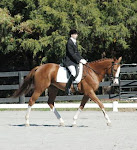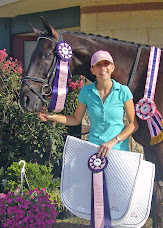On Friday, Jocelyn and her horse Moo wanted to know why some horses need clips and what they are for.....
Arvin Reynolds' answers:
Clips are used to stabilize the shoe on the horse's hoof. There are several reasons why one horse's hoof may need that extra help more than another. If you jump your horse, your farrier may use toe clips (one clip on the front of the shoe) to keep the shoe from slipping backward. On the hind hooves, quarter clips (one on each side of the hoof) are sometimes used to keep the shoe from slipping.
Whether your horse needs clips or not should be determined by the quality of the hoof, the type and intensity of the horse's work load, and the way the horse uses his shoes. Some horses are just harder on their shoes than others due to confirmation, way of going, or habits (playing hard in the field, for example).
There are no grave side effects to using clips - they are just a tool to keep the shoe in the optimum position on the hoof. Hope this answers your question!
Arvin Reynolds is an AFA & BWFA Certified Farrier specializing in therapeutic shoeing. He can be reached at 703-895-4786 or AGRShoeing@aol.com
Saturday, February 9, 2008
Ask the Farrier - What's the Deal With Clips?
Friday, February 8, 2008
Horse Training Tip - Help for 3 Common Longing Problems
Ask the Farrier Friday - Do My Horse's Hooves Need Clips?
Jocelyn emailed this question regarding her 12 year old Quarter Horse, Moo:
"Why do some horses need clips and others don't? What exactly are they for and are there any negatives to them? My horse Moo has been in clips on all four feet since I've owned him (3 years)."
Thanks for the question, Jocelyn. Check back tomorrow, Saturday, to see the answer from certified farrier Arvin Reynolds.
Thursday, February 7, 2008
Good Horseperson's Vocab Word-of-the-Day: Enzootic
 Working "enzootic" into your daily conversation may be nearly impossible, but it's a handy word to have in your head to impress your vet during spring shot season. The Good HorsePerson learned this word from an recent article in Equestrianmag.com regarding Equine Influenza. It seems like a fitting follow-up to our 10 Steps to Disease Prevention.
Working "enzootic" into your daily conversation may be nearly impossible, but it's a handy word to have in your head to impress your vet during spring shot season. The Good HorsePerson learned this word from an recent article in Equestrianmag.com regarding Equine Influenza. It seems like a fitting follow-up to our 10 Steps to Disease Prevention.
Wednesday, February 6, 2008
48 Thoroughbred Horses Seized in Virginia
Tuesday, February 5, 2008
Good Horse Health: 10 Steps for Disease Prevention
1) Select the Right Vaccines. Crabbe writes that the most commonly admistered "core" vaccines are tetanus, sleeping sickness, influenza and West Nile and sometimes Rhino. Crabbe advises to select other vaccines based on geographical location and individual horse's exposure risks, like traveling habits. She advises every horses owner to question their vets as to which specific vaccines they reccomend and why.
2) Time the Administration of the Vaccines Properly. Crabbe advises vaccinating 3-4 weeks prior to the time when you think risk of exposure is highest (give West Nile in early spring, before the insects come into full bloom).
3) Administrate the Vaccines Properly. Here's a bit of a no brainer, but makes perfect sense. Crabbe advises that if you inject the vaccines yourself, ask the vet to teach you how or make sure you're doing it right.
4) Consider Your Horse's Turn Out Buddies. Try to keep all horses turned out together on the same vaccine schedule.
5) Utilize Isolation Strategies. Crabbe says the ideal quarentine for boarding barn is 30 days for incoming horses. (hmmm, that IS ideal!, but probably not possible at most barns...) And a good tip for isolation on the road is to keep your horse 35-50 feet away from other horses on the grounds.
6) Choose Stalls Near Horses in a Similar Risk Group as Your Own. Again, great idea and makes good sense, but probably not possible in a huge boarding facility where the barn manager is struggling to keep Food-Possessive Alpha Mare and Jealous Stall-Kicking Gelding away from each other while keeping the 50 individual owner's stall requests in mind. But the idea of grouping show horses that travel often together and horses that rarely travel is a good one, for those who can manage it.
7) Disinfect. When stabling at an overnight show, Crabbe advises spraying down the stall walls with an "effective" disinfectant (one that includes phenolic-based products). She notes that bleach is not so effective against organic material like manure.
8) Avoid Sharing - Crabbe notes that horses purposely stabled away from one another shouldn't share paddocks or water tubs. Spreading manure on shared turnout fields should be avoided for the same reason.
9) Minimize Stress (This is the Good HorsePerson's favorite tip!). Give your horse a routine in his daily life - feeding, turnout and exercise. Horses who know what to expect trust their surrounding and their people. Low stress horses have stronger immune systems, just like people.
10) Keep Your Horse in Good Health - This isn't so much a tip as a summary, I suspect.
The Good HorsePerson would like to add one more tip to Dr. Crabbe's list.
11) Pay Attention - Learn your horse's personality, likes, dislikes and habits (without humanizing him too much) so that alarm bells go off when he just isn't acting right. Learn how to take a temperature, observe the color and consistency of the manure and nasal discharge every day, know every blemish and bump and discoloration, and make sure you can handle every single part of him or her without objection (if they start objecting out of the blue, you can bet they're uncomfortable). This tip won't keep your horse from catching a virus, but you might recognize it first, save your horse and stop an outbreak.
Dr. Crabbe recently published a new book, "The Comprehensive Guide to Equine Veterinary Medecine" which is available from http://www.horsebooksetc.com/ Dressage Today is published by Source Interlink Media, and you can subscribe at www.equisearch.com/dressagetoday/
Monday, February 4, 2008
Budweiser Horse Rocky wins #1 Super Bowl Ad for 2008
Sunday, February 3, 2008
Ask the Farrier: High Heel, Low Heel Syndrome
Krista from Mattoon, IL asks:
"My farrier said my horse has something called High Heel/Low Heel Syndrome and that's why his hoof angles don't look very even from the side. Can you tell me more about it? Can it affect my horse's movement? Is there a treatment?"
Farrier Arvin Reynolds answers:
Thanks for the question, Krista. High Heel/Low Heel Syndrome is a very common imbalance associated with the front pair of hooves. Very simply, one heel looks higher than the other and tends to grow that way despite some corrective shoeing measures.
The majority of horses have, to some degree, dissimilar hoof size and/or growth patterns for which there are many possible causes such as the horse’s typical “grazing stance” (repetitive position when one hoof is positioned in front of the other for balance when lowering the neck to graze) or way of going due to confirmation and/or muscular development. A mature horse’s irregular or otherwise undesirable hoof shape may even have been caused by excessive protein intake as a foal.
Depending on the degree of the imbalance, movement can be affected. The leg with the more upright hoof (higher heel) will tend to have a shorter stride; the leg with the lower heeled hoof will be a bit longer in stride. Overly upright hooves are susceptible to arthritis or other joint disorders; Too-low heels receive too much impact, resulting in sore heels or, possibly, navicular disorders.
Your farrier’s job is not necessarily to “correct” the imbalance as that may not be possible, it may be better to think about “managing” it. The upright hoof should have as much heel taken off as possible on each shoeing ; the lower-heeled hoof may need to be addressed with pads to reduce concussion and encourage growth, and the breakover on this hoof should be moved back as far as possible. Every horse, and thus, every shoeing case is different. Feel free to email some pictures – front and side on a level surface – to the Good HorsePerson if you have any further concerns. Hopefully I’ve addressed your question! -Arvin Reynolds
Arvin Reynolds is an AFA and BWFA Certified Farrier specializing in therapeutic and sport horse shoeing. He is currently the sole farrier for the United States Park Police in Washington, DC. He is also one of two certified Cytek shoers in Virginia. He can be reached by phone at 703-895-4786 and email AGRShoeing@aol.com










